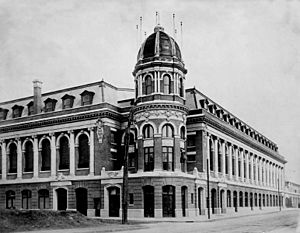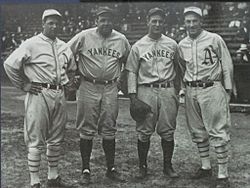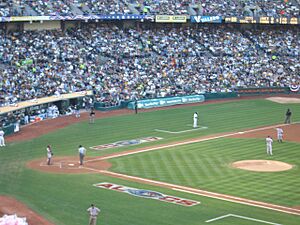History of the Athletics facts for kids
The Athletics, also known as the A's, are a Major League Baseball team with a long history. They started in 1901 in Philadelphia. In 1955, they moved to Kansas City for 13 years. Then, in 1968, they moved to Oakland, California, where they played for 57 seasons. The team had problems with their old stadium in Oakland, so in 2023, MLB owners approved their move to Las Vegas, Nevada. The A's have had more home cities than any other MLB team.
Contents
Philadelphia (1901–1954)
A Strong Start
In 1901, the American League became a new major league, and Philadelphia got a new team to compete with the city's other team, the Phillies. This new team was the Athletics.
The team was managed by Connie Mack, a former catcher. He got people like Ben Shibe to invest money in the team. The team's name came from an older baseball club from the 1800s. Their first home was Columbia Park.
First Dynasty and a Big Fall
The A's quickly became one of the best teams in the league. They won the American League pennant six times between 1902 and 1914. They also won the World Series in 1910, 1911, and 1913. Their amazing group of players was called the "$100,000 infield."
In 1909, the A's moved into Shibe Park, one of the first baseball stadiums made of concrete and steel. By 1912, Connie Mack had gained full control over all baseball decisions for the team.

In the 1914 World Series, the A's lost badly to the Boston "Miracle Braves." After this loss, Mack sold or released most of his star players. He said the team was distracted by a new league, the Federal League, which was trying to sign his players. Mack decided to rebuild with younger, less expensive players. This led to a total collapse. In 1916, the team had one of the worst records in baseball history, with only 36 wins and 117 losses. They finished in last place for seven years in a row.
Second Dynasty (1927–1933)
By the late 1920s, Mack had built another amazing team. It featured future Baseball Hall of Fame members like Al Simmons, Jimmie Foxx, Mickey Cochrane, and pitcher Lefty Grove.
This team won the American League pennant in 1929, 1930, and 1931. They also won the World Series in 1929 and 1930. They were just as good as the famous New York Yankees of that time, but because they played in a smaller city, they are not as well remembered.
This success did not last. The Great Depression meant fewer fans came to games, and the team lost money. Just like before, Mack sold his best players to save money. By 1934, the team was no longer a winner.
The Lean Years and Final Days in Philadelphia
The A's struggled for the next 30 years. They usually finished in last or next-to-last place. Mack was getting very old, and some said he was no longer fit to manage the team. He would sometimes make strange decisions during games. Still, he refused to step down.
By the late 1940s, the A's had a few winning seasons, but they couldn't compete with the now-popular Phillies, who went to the 1950 World Series. It was clear the Phillies were Philadelphia's number-one team.
After the 1950 season, Mack finally retired as manager at age 87. His sons took over, but the team was deeply in debt. They had no choice but to sell the team. In 1954, a Chicago businessman named Arnold Johnson bought the A's. The other American League owners wanted the team to move, so they approved Johnson's plan to relocate the team to Kansas City. This ended the A's 54-year history in Philadelphia.
Kansas City (1955–1967)
The Johnson Era and the "Special Relationship"
When Arnold Johnson moved the A's to Kansas City, Missouri, fans were excited. In their first year, the Kansas City Athletics set a team record for attendance. However, it soon became clear that Johnson had a very close relationship with the New York Yankees.
Johnson often traded his best young players to the Yankees for older players and cash. Stars like Roger Maris and Clete Boyer were sent to New York. This led many to accuse the A's of being a "farm team" for the Yankees, helping them win championships. The A's were never a winning team in Kansas City under Johnson. He died suddenly in 1960.
The Charlie Finley Era
In late 1960, Charlie Finley, an insurance businessman, bought the team. He promised to keep the team in Kansas City and build a winner. He famously burned a bus with "New York" on it to show that the special trading relationship with the Yankees was over.
Finley was a showman. He changed the team's colors to green, gold, and white. He also introduced a real mule named "Charlie O" as the team's mascot. He made many changes to the uniforms and the stadium to attract fans.
While the team was still losing, Finley invested heavily in finding and developing young players. For the first time, the A's built a strong farm system. This led to the drafting of future stars like Rick Monday.
Despite his promises, Finley soon started looking to move the team. He tried to move to cities like Louisville and Dallas but was blocked by the other MLB owners. Finally, in 1967, the owners gave him permission to move the team to Oakland, California. This angered many people in Missouri, including Senator Stuart Symington, who fought to get a new team for the city. His efforts led to the creation of the Kansas City Royals.
Oakland (1968–2024)
A New Home and a New Powerhouse
The A's began playing in the new Oakland–Alameda County Coliseum in 1968. The team quickly improved. Led by slugger Reggie Jackson, the A's finished with winning records in 1968 and 1969. By 1971, they were division champions.
The "Swingin' A's" Dynasty (1971–1975)
From 1972 to 1974, the A's became a true dynasty. They won three World Series championships in a row. The team was known as the "Swingin' A's" for their powerful hitting and colorful personalities. Key players included Reggie Jackson, Catfish Hunter, Rollie Fingers, and Vida Blue.
The team was also famous for its unique look. Owner Charlie Finley had them wear bright green and gold uniforms. He also paid his players to grow mustaches, which was very unusual at the time.
Despite their success, many players did not like Finley. He often argued with them over contracts and tried to control every part of the team. After winning the 1974 World Series, star pitcher Catfish Hunter left the team. This was the beginning of the end for the dynasty. Finley began trading away his star players because he didn't want to pay them the high salaries they could now get as free agents.
Tough Times and a New Owner
After the dynasty was broken up, the A's became one of the worst teams in baseball. From 1977 to 1979, they finished in last place. So few fans came to the games that the stadium was called the "Oakland Mausoleum." Finley tried to sell the team and move it to Denver or New Orleans, but the city of Oakland blocked him.
Finally, in 1980, Finley sold the team to Walter A. Haas, Jr., the president of Levi Strauss & Co..
The Haas Era and "The Bash Brothers" (1981–1995)
The new ownership changed the team's image. They brought back the traditional "Athletics" name and the elephant mascot. Fans returned in huge numbers.
The team was rebuilt around young sluggers José Canseco and Mark McGwire, who were known as the "Bash Brothers." From 1988 to 1990, the A's won the American League pennant three years in a row. They won the 1989 World Series against their rivals, the San Francisco Giants. That series is famous for being interrupted by the Loma Prieta earthquake.
The A's also had superstar Rickey Henderson, who set the all-time record for stolen bases in a career.
The "Moneyball" Years (1996–2004)
After Walter Haas died, the team was sold again. The new owners cut costs, and stars like McGwire were traded away. General Manager Billy Beane had to find a new way to win with a very small budget.
Beane used a strategy called "Moneyball." He signed players that other teams overlooked, focusing on statistics like on-base percentage instead of more traditional skills. This strategy worked. The A's made the playoffs four years in a row from 2000 to 2003, even though they had one of the lowest payrolls in baseball. The team was led by a trio of great pitchers known as the "Big Three": Tim Hudson, Mark Mulder, and Barry Zito.
In 2002, the A's won 20 games in a row, which was an American League record.
The Wolff Era and More Playoff Runs (2005–2016)
In 2005, the team was sold to a group led by Lewis Wolff. The A's continued to find success, returning to the playoffs in 2006.
In 2012, the A's shocked the baseball world by winning the AL West division on the final day of the season. They won the division again in 2013. Both years, they lost a dramatic five-game playoff series to the Detroit Tigers.
After a playoff appearance in 2014, the team began to struggle, finishing in last place for three straight years.
The John J. Fisher Years and Final Seasons in Oakland
From 2018 to 2020, the A's returned to their winning ways, making the playoffs for three consecutive seasons. The team was led by stars like Matt Chapman and Matt Olson.
However, the team's owner, John J. Fisher, began looking to move the team. The Oakland Coliseum was old and needed to be replaced, but the team and the city could not agree on a plan for a new stadium. In 2021, MLB allowed the A's to start exploring relocation.
Before the 2022 season, the team traded away most of its star players. The A's had one of the worst records in baseball in 2022 and 2023.
In April 2023, the team announced it had a deal to build a new ballpark in Las Vegas. In November 2023, MLB owners officially approved the move. The team announced that the 2024 season would be its last in Oakland. The A's played their final game at the Coliseum on September 26, 2024, winning 3–2 against the Texas Rangers.
Sacramento (2025–present)
The 2025 season is the first for the Athletics at Sutter Health Park in West Sacramento, California. This is the home of the minor league Sacramento River Cats. The team will play in Sacramento for three seasons while their new stadium in Las Vegas is being built. During this time, the team is known simply as the "Athletics," without a city name.











